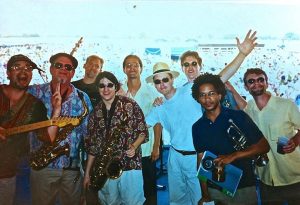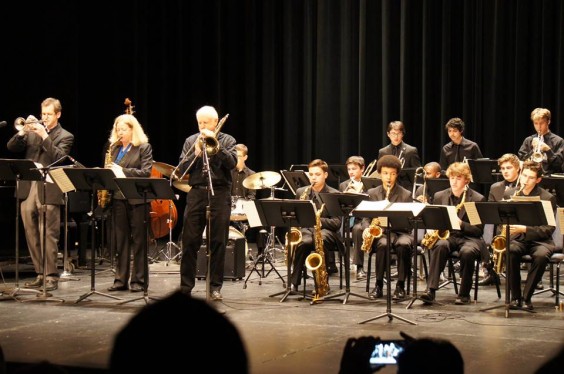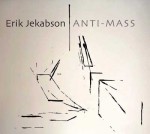Erik Jekabson: “Things Seem To Be Going Alright.”
by Alex Walsh

“Just keep on producing quality work and do your best to promote yourself as best you can and hope that people notice. And if they don’t, that’s okay, you still get to play good music.” – Erik Jekabson
Erik Jekabson is a trumpet player, composer, arranger and educator. He performs throughout the Bay Area as a bandleader with his many groups, and as a freelancer.
Originally from Berkeley and a graduate of the Berkeley High Jazz program, Erik went to Oberlin as an undergraduate, and then to New Orleans where he learned how to be a professional musician. “I went there at the age of 21 in my senior year of college, 1995. I didn’t want to move to New York right away because it was pretty intimidating.”
Erik played in cafes and bars in the French Quarter and eventually worked on Bourbon Street in a place that was run by the mob. “I made $60 for 5 hours plus tips. I learned all these Trad Jazz / Dixieland tunes which has really helped me in being more versatile.”
In 1996 a friend recommended that Erik join the jazz funk jam band, Galactic. For a few years he was one of their regular horn players and ended up writing their horn charts, many of which ended up on their first album. He still receives payments from those recordings.

New Orleans, 1998, at the New Orleans Jazz and Heritage Festival with the New World Funk Ensemble, a band Erik co-led with guitarist Todd Duke. From Left to Right: Todd Duke, Loren Pickford, Sam Price, Scott Bougeious, Michael Skinkus, Karl Budo, Erik Jekabson, Grant Harris, Charlie Dennard
When he joined the New Orleans musicians union Local 174-496, Erik says he started getting better gigs immediately. “I joined the union to play the riverboats, the American Queen and the Mississippi Queen, with Al Belletto’s Big Band. I also subbed in a smaller sextet, backing up singers and playing traditional jazz. I got to travel up the Mississippi while reading Huck Finn.” The musicians were considered officer status which meant they could walk around above deck during the day, eat food and mingle with the guests, while the regular crew were required to stay below. “They were fancy boats. I’d fly in to Vicksburg on a little prop jet and meet the boat there and then go up to Memphis.”
The New Orleans union rehearsal hall was very active. Erik says he rehearsed and played a few gigs with Wardell Quezergue, the arranger who did all the charts for Alan Toussant and the Meters. “He had big band charts for all these tunes like, “Iko Iko“ and “Big Chief”, but orchestrated in this very cool way. I got to rehearse with him 2 or 3 times, and do a couple gigs. I heard recently that all those charts were lost in Katrina.”
NEW YORK
In 1999, Erik took the plunge and moved to New York. “New York was astronomically bigger than New Orleans. I knew a ton of people there from New Orleans and Oberlin and joined what they were already hooked into.” He joined Local 802 and established himself on the wedding band scene, working with the Hank Lane Club Date Agency. “They made an agreement with the union, so they were union gigs, top 40 stuff, bar mitzvahs and weddings on Long Island.” Erik lived with two other musicians in Brooklyn where they had jam sessions during the day at their apartment. He was able to scratch out a living from music but had to take a day job after 9/11.
“I was doing weddings and played Jazz gigs once in awhile. I wasn’t even teaching. I was single and eating pasta every night. I did a few tours with Illinois Jacquet; that paid alright. Then 9/11 happened and everything went bad. Gigs got cancelled and the economy tanked. So I did temp work for a little while.”

Playing on the John Mayer tour in 2004 David Labruyere, bass, DJ Logic, turntables, Erik Jekabson, trumpet, Chris Karlic, soprano sax, Jesse Carmichael, keyboards, John Mayer, guitar
After a couple years, the economy improved and by the time he left, Erik was playing with a lot of groups he really enjoyed. He also began leading his own groups. “I did one CD there. It came out after I left. It was on a Spanish label called Fresh Sound, New Talent. It got reviewed in some of the magazines.”

Performing with his stringtet at the DeYoung Museum, 2012. (L-R) Charith Premawardhana, John Wiitala, Mads Tolling, Smith Dobson, Mike Zilber, Erik Jekabson
Erik says he knew he didn’t want to live in New York forever. “The weather’s really extreme and there are so many people–it’s intense. My family is here. If I’d stayed there I know things would have gotten better. The people who have stayed there have done well.”
BACK IN THE BAY AREA
Erik returned to the Bay Area in 2003 to go to graduate school at the SF Conservatory of Music, but during the first couple weeks of school he got a call asking if he wanted to go on the road with John Mayer. “I was like, ‘I think I’ve heard of him…’”
Erik ended up taking a leave of absence from the conservatory. The tour turned out to be 5 six-week tours with a month off in between.
“Tour busses, a couple private jets; that was a whole other level of touring. We did Letterman and the Tonight show. It was exciting to play in stadiums and see how that part of the industry worked. John Mayer is a brilliant dude. He’s super talented, a good bandleader and performer, and writes good tunes. I got to see him do his thing.” Though the experience wasn’t very satisfying artistically, Erik says it worked out well financially. “If John did 15 tunes a night, we’d play on 6. Every six weeks I’d get a solo. It was a good experience and I’m glad I did it. Of course I met my wife, Emily, and we have a kid now. She was the merchandise manager.”

Erik Jekabson, Mary Fettig and Dave Eshelman performing with the California Jazz Conservatory Studio Band, a band made up of top High School players from around the Bay Area.
Erik finished his degree in 2006 and has since immersed himself in the Bay Area jazz scene. He now lives in El Cerrito with his family and is on staff at the California Jazz Conservatory where he runs the youth program. He also teaches privately. Erik says many if not most of the musicians in the jazz scene are teaching. “If you’re a fulltime jazz musician than you’re probably not supporting anyone but yourself. I know a lot of people who are doing it and playing every night. Some of the places you just play for the door percentage and probably make anywhere from $60 – $100. There are a ton of great musicians here and I’m constantly meeting new people or finally meeting people that I hadn’t met. There are some really great places to play that try to treat musicians well.”
One of Erik’s projects, The Electric Squeezebox Orchestra, is currently doing a Sunday night residency at Doc’s Lab in North Beach. They’ve been working with Jazz In The Neighborhood to bring students out to perform sets before their regular shows. Erik thinks creating this educational component is the key to keeping jazz alive. “Your students come and see you at your gigs, they come and support, buy CDs, and years later they may hire you for gigs. I think the jazz education scene in the Bay Area is super strong. There are so many smart teachers here and parents that can hire them, and even if they can’t, there are all these great programs like the California Jazz Conservatory, the Oaktown Jazz Workshop and the Richmond Jazz Collective, and all these camps. Most of these great players that I’m playing with, they’re all teaching at these places.”

The Electric Squeezebox Orchestra, 2014 Back row: Charlie Gurke, Jordan Samuels, Grant Levin, Mike Zilber, Eric Garland, Kasey Knudsen, Mark Rosenberg, Sheldon Brown, Mitch Butler, Rob Ewing, Darren Johnston, Patrick Malabuyo, Rich Lee, Marcus Stephens Front Row: Henry Hung, Tommy Folen, Dave Scott, Erik Jekabson
Erik says his basic plan is to keep on writing, arranging, performing, and producing recordings. “Putting out CDs is really helpful in building up your resume, getting better gigs and more exposure to the general public. Some of the CDs are geared toward exposure, and some of them are more artist focused. Being a bandleader, you really have to get your name out there. That really didn’t come easily for me. Now I find myself spending a lot of time doing that because I realize how important it is to promote yourself, get people to come to your shows, get a mailing list, and put out a newsletter.”
Erik says it was hard during the recession but at the present time things seem to be on an upswing. “The Stanford Jazz Workshop is expanding, SF Jazz is expanding, the California Jazz Conservatory is expanding–as long as the economy is going well there’ll be more opportunities for teachers and players to teach and play. And hopefully, all of these students coming out of these schools will be supporters and players themselves.”
 Erik has produced three CDs since returning to the Bay Area, all on his own record label, Jekab’s Music. “Crescent Boulevard” (2009) features small group modern jazz, “Anti-Mass” (2011) features string-tet (trumpet, sax, violin, viola, bass, drums, vibes) playing his original
Erik has produced three CDs since returning to the Bay Area, all on his own record label, Jekab’s Music. “Crescent Boulevard” (2009) features small group modern jazz, “Anti-Mass” (2011) features string-tet (trumpet, sax, violin, viola, bass, drums, vibes) playing his original  compositions inspired by artwork at the DeYoung museum and has classical, jazz and avant-garde influences, and “Erik Jekabson Quartet and John Santos: Live at the Hillside Club” (2013) is a live concert featuring his quartet with special guest percussionist John
compositions inspired by artwork at the DeYoung museum and has classical, jazz and avant-garde influences, and “Erik Jekabson Quartet and John Santos: Live at the Hillside Club” (2013) is a live concert featuring his quartet with special guest percussionist John  Santos. Both “Anti-Mass” and “Live at the Hillside Club” were made possible by a grant from SF Friends of Chamber Music.
Santos. Both “Anti-Mass” and “Live at the Hillside Club” were made possible by a grant from SF Friends of Chamber Music.
For more info visit www.erikjekabson.com
